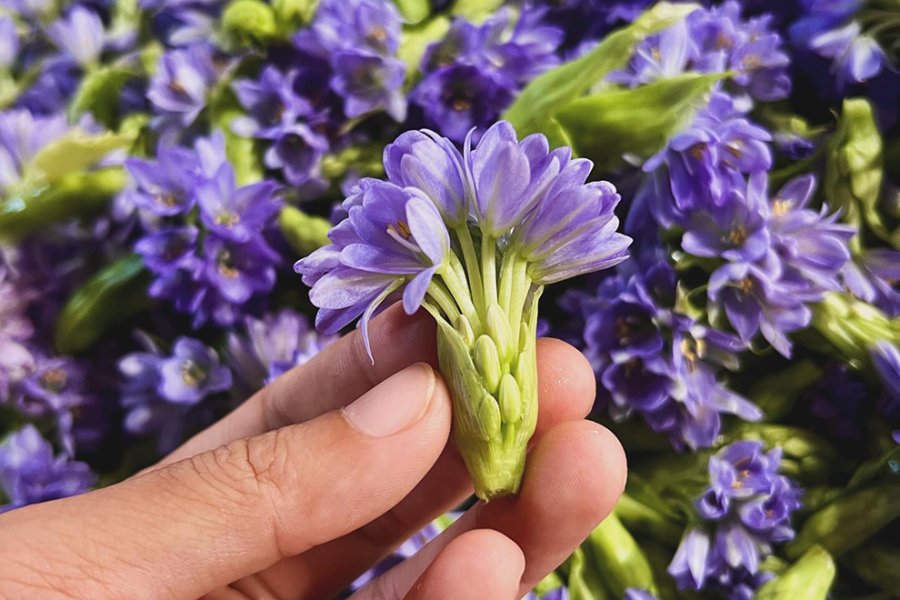September 18, 2024
PHNOM PENH – As Cambodia’s monsoon rains fall from May to October, the country’s landscape is transformed, bringing a unique bounty of ingredients to markets and kitchens across the nation.
September, the heart of the season, provides an opportune moment to explore the rich, seasonal cuisine of the rainy season – a time when nature is at its most generous.
Ros Rattanak, better known as celebrity Chef Nak, offers a deep connection between these seasonal changes and traditional Khmer cuisine, making the rainy season an exciting period of culinary exploration.
A season of abundance
The rainy season breathes life into Cambodia’s rivers, lakes and farmlands. According to Chef Nak, the essence of Khmer food is deeply tied to its ingredients, which reflect the season in which they are harvested.
“The taste of food in the rainy season is more diverse and richer than during the dry season. The fresh ingredients we get from the land, forests and water sources during these months are unparalleled,” she explains.
Among the most prized ingredients are freshwater fish, such as trey riel (small carp), trey chhlang (snakehead fish) and trey sloeuk russey (catfish), which thrive as the rains replenish the Kingdom’s waterways.

Some of the traditional ingredients she uses include fresh crape myrtle leaves(left) and fragrant rice paddy herb (right). PHOTO: SUPPLIED/ THE PHNOM PENH POST
These fish form the foundation of many rainy season dishes, their flavour enhanced by the nutrient-rich waters in which they grow.
Wild herbs and vegetables, such as rice paddy herb (Limnophila conferta), are also key players in the seasonal cuisine.
“There are two types of rice paddy herb,” Chef Nak notes.
“The one from the rice fields has a more fragrant smell during the rainy months, elevating dishes like crushed smoked fish with young tamarind to a new level,” she adds.
The abundance of young tamarind and tamarind sprouts during this time brings a fresh, sour taste that is essential in many rainy season recipes.
Seasonal delicacies
Foraging is an important aspect of rainy season cooking, with wild mushrooms and bamboo shoots popping up in forests and wetlands.
These ingredients make their way into traditional dishes like Samlor Kor Ko, a mixed vegetable soup that combines bamboo shoots, wild ferns and freshwater fish, all simmered in a broth flavoured with prahok (fermented fish paste) and lemongrass.

Chef Nak prepares dishes which reflect her deep love for traditional Khmer culture. PHOTO: SUPPLIED/ THE PHNOM PENH POST
Another seasonal favourite is Samlor Machu Kreung, a sour soup featuring snakehead fish, tamarind and wild mushrooms.
The balance of sour and spicy flavours makes this dish particularly comforting during the cooler, rain-drenched days.
Prahok Ktiss, a savory dip made from prahok, pork and coconut milk, is often served with fresh seasonal vegetables, taking full advantage of the harvests brought by the rains.
Cultural traditions and community bonds
Beyond the flavours and ingredients, the rainy season fosters a deeper sense of community and tradition.
As the rains slow down farming activities, families in rural areas gather more frequently to enjoy meals together.
“In the rainy season, the food brings people together,” Chef Nak recalls. “Families bond over cooking, and the meals are shared among everyone, strengthening family ties.”
This season also reflects traditional Khmer values around food. Chef Nak shared memories of how, as a child, serving chicken to a guest was considered a great honour because it was expensive.
During religious festivals like Pchum Ben, offerings of food to monks take on special significance.

The common water hyacinth is also a major part of her repertoire of fresh ingredients. PHOTO: SUPPLIED/ THE PHNOM PENH POST
“The food we offer during Pchum Ben represents what we want to give to our ancestors,” Chef Nak explains. “But in recent times, we’ve lost focus on the lighter, seasonal dishes that once defined our meals.”
Instead of elaborate meat-heavy dishes, Chef Nak advocates for a return to simpler, seasonal foods like fried fish with pickles or sour fish soup with shrimp and vegetables.
These lighter offerings not only align with tradition but also highlight the abundance that the rainy season brings.
Embracing the ingredients of the season
Certain herbs, like balsam and sage, thrive specifically in the wet conditions of the rainy season, contributing to the richness of rainy-season cuisine.
Chef Nak also mentions the importance of Java Cola, a plant whose fruit, flower and buds add distinctive flavours to various dishes during this time of year.
Insects, like crickets, coconuts, spiders and even trapdoor spiders were also once part of the rainy season diet, a testament to Cambodia’s resourcefulness and the natural cycles of its ecosystem.
“These insects were delicious and fragrant when cooked,” Chef Nak reminisces, underscoring how Khmer cuisine is deeply connected to the environment.
A call for simplicity and tradition
Chef Nak urges Cambodians to revisit their culinary roots, particularly in the context of religious festivals.

Chef Nak shows international visitors some Cambodian fish pastes and other traditional ingredients. PHOTO: SUPPLIED/ THE PHNOM PENH POST
“We’ve grown used to lavish, meat-heavy meals, but the essence of our cuisine is found in the fresh, seasonal ingredients that thrive during the rainy season,” she told The Post.
“By focusing on these local, seasonal foods, we not only honour our traditions but also promote sustainability and community.”
She recalls how, in the past, her parents would prepare unique dishes for the pagoda, such as fried fish with Java Cola or sour fish soup with shrimp and vegetables, instead of the typical pork or beef dishes.
“It was the joy of using what nature provided during the rainy season that made the food so special,” she continues.
A celebration of nature’s gifts
The rainy season in Cambodia is not just a time of abundance but also a celebration of the land, the people, and the deep cultural significance of food.
From the foraging of wild herbs and mushrooms to the communal preparation of traditional dishes, this season embodies the essence of Khmer cuisine – a harmonious blend of nature, family, and tradition.
Chef Nak’s reflections remind us of the beauty in simplicity and the importance of staying connected to the land.
She says, “Each dish tells a story – of the season, the land and the people who come together to enjoy it.”


